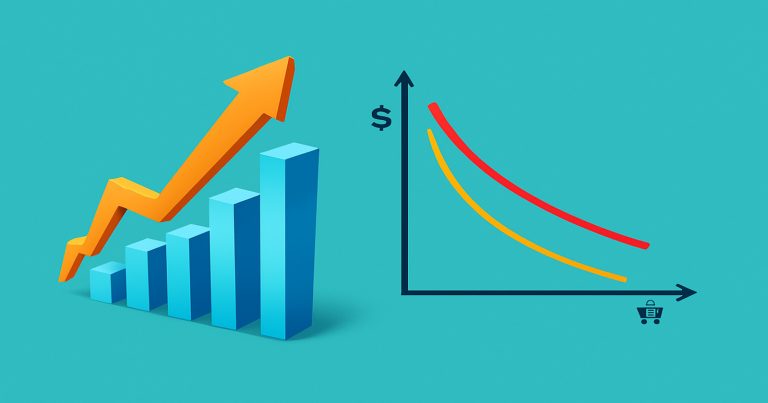Elasticity of demand is one of the most essential concepts in microeconomics and managerial decision-making. It explains how consumers react to changes in various economic factors, primarily price, and how those reactions influence the quantity demanded for a particular good or service. Businesses can better plan pricing strategies by measuring elasticity, while economists and policymakers can design efficient taxation and subsidy models. In simple terms, elasticity gives insights into consumer sensitivity and helps forecast market behavior more accurately.
What is Elasticity of Demand?
In this section, the term elasticity and its economic implications are approached at a basic level. Demand refers to the quantity of something demanded by the consumer, as the demand varies with some influencing factor, in this case, price. Consumers’ attitude forms the basis of further examination concerning pricing, marketing, and government economic policy.
Demand elasticity refers to the responsiveness of consumers to changes in the price of a good or service, income levels of consumers, or prices of related goods. Highly elastic goods experience significant shifts in demand with minimal price changes. Price-inelastic goods maintain their demand irrespective of the cost. Demand elasticity analysis is essential in price-setting and analysing the factors governing demand.
3 Cases of Demand Elasticity
An introduction to the three principal cases concerning demand will set the background for the formulas and calculations. These cases describe the changes in quantity demanded under extreme or balanced elastic situations. These cases are used by businesses to segment products and predict revenue outcomes when prices change.
Perfectly Inelastic Demand
Perfectly inelastic demand exists when quantity demanded remains constant under any price change. This applies to goods that are essential for survival or subsistence. Such goods have a vertical demand curve with zero elasticity, so consumers will buy them regardless of price.
Unitary Elastic Demand
Unitary elasticity represents a balanced scenario where the percentage change in price equals the percentage change in quantity demanded. This is rare in fundamental markets but helps businesses evaluate points of revenue neutrality when altering prices.
Perfectly Elastic Demand
In this scenario, even the slightest price increase results in consumers buying zero product units. Perfectly elastic demand exists primarily in theoretical models or highly competitive markets with undifferentiated products. The demand curve is horizontal, and elasticity is infinite.
Types of Elasticity of Demand
Elasticity is not a one-size-fits-all concept. It varies based on what factor influences the change in demand: price, income, or the price of related goods. Each type offers unique insights, helping businesses craft targeted marketing strategies and economists understand consumer trends. The types of elasticity of demand are as follows:
Price Elasticity of Demand (PED)
Price elasticity of demand is the most commonly used type and evaluates how much quantity demanded changes in response to price changes. This is vital for pricing strategies, discount planning, and determining the price point that maximises revenue without losing customers.
Income Elasticity of Demand (YED)
Income elasticity of demand focuses on the impact of consumer income changes on product demand. It helps classify goods as necessities, luxuries, or inferior goods. Marketers and product developers use this to predict how economic growth or recession will affect demand.
Cross Elasticity of Demand (XED)
Cross elasticity is simply the estimate of how the demand for one product is affected by the price change of another. It is essential for competitive and complementary markets. It aids in identifying substitutes and complements; hence, it is necessary for strategic business alliances and competitive positioning.
Factors Affecting Elasticity of Demand
The parameters determining whether demand for a particular good is elastic or inelastic and related concepts. These allow businesses to hold a view of customer reaction toward price changes and thus amend their strategies relating to marketing or supply.
Availability of Substitutes
Where substitutes are viable, consumers have a greater chance of switching to alternative goods; hence, the demand becomes more elastic. These are conditions of goods in competitive markets, compelling those companies to keep their prices in check.
Necessity vs. Luxury
Whether a good is essential or optional greatly influences elasticity. Necessities usually have inelastic demand since people must buy them regardless of price. Luxuries, being optional, often exhibit high elasticity because their consumption can be delayed or avoided.
Proportion of Income Spent
Demand tends to be more elastic if a product consumes a large portion of a consumer’s income. Even small price increases in such goods can significantly impact affordability and purchasing decisions.
Period elasticity
Period elasticity can vary depending on the time consumers have to respond. In the short run, many goods have inelastic demand, but over time, the demand becomes more elastic as people find alternatives.
Addictive Nature
Other goods like alcohol or tobacco usually have inelastic demand since they are somewhat addictive. Such products see continuous purchases even with a price increment, owing to psychological or physical dependability.
Formula for Elastic Demand
Technically, understanding elasticity helps in its practical application. This section overviews the fundamental formula for measuring demand response to price changes. This mathematical expression is, therefore, the basis upon which businesses, economists, and students rely for decision-making based on available data.
The elastic demand formula is written as
Price Elasticity of Demand (Ed) = (% Change in Quantity Demanded) ÷ (% Change in Price)
This formula helps determine the degree of elasticity: values above 1 indicate elastic demand, values below 1 indicate inelastic demand, and precisely 1 indicates unitary elasticity.
Determinants of Price Elasticity of Demand
The next step would be to study demand elasticity in the real world, which will be well understood before the analyses are given. These are the key factors, which are referred to as determinants of price elasticity of demand, that determine if the demand for a product is elastic, inelastic, or unitary. These would affect consumer behaviour accordingly when responding to price changes. Understanding these principles will help businesses price their goods wisely and allow economists to forecast market response to different conditions.
Availability of Substitutes
The more substitutes a product has, the more elastic its demand will be. When similar goods are readily available, even a small price hike can prompt consumers to switch to alternatives. For example, if the price of a particular brand of chips increases, customers may simply buy a different brand, reflecting elastic demand.
Nature of the Good: Necessity vs. Luxury
Necessities tend to have inelastic demand because they are essential for survival or daily life—think of rice, salt, or electricity. Luxuries like movie tickets or designer bags are more elastic, as consumers can postpone or forego such purchases if prices rise.
Proportion of Income Spent on Goods
Goods that take up a large share of a consumer’s income usually have more elastic demand. For example, a 10% price increase in rent has a larger financial impact than a 10% increase in toothpaste prices, making rent more elastic.
Period Considered
Elasticity tends to be lower in the short run because consumers need time to adjust their consumption habits. Over the long run, demand becomes more elastic as consumers explore alternatives or adopt new consumption patterns. For example, people might not reduce electricity usage immediately after a tariff hike but may invest in solar panels over time.
Addictive or Habitual Consumption
Goods such as cigarettes, alcohol, or coffee frequently exhibit inelastic demand because of their addictive qualities. Therefore, even if prices increase tremendously, regular users will still buy these goods, thus making the demand for them less responsive to price changes. By examining these determinants, businesses can predict elasticity levels more accurately and then use them to set prices, plan promotions, and forecast revenue more precisely.
Steps to Calculate Elasticity of Demand
Elucidating the steps of calculating elasticity of demand and applying elasticity formulas in the best possible way requires a perfect understanding of every step involved. This handling section outlines the practical process of calculating elasticity by inserting actual values and interpreting the result.
1. Percentage Change in Quantity Demanded
This will tell how much demand is changing compared to the previous level of demand. This is a determinant for the numerator in the elasticity formula.
2. Percentage Change in Price
After that, the rate at which the price changes has to be measured. This gives the denominator and tells how significant the price variation is.
3. Then, Use the Elasticity Formula
Last, we divide the percentage change in demand by the percentage change in price. The finding indicates whether demand is elastic, inelastic, or unitary.
Importance of Demand Elasticity
The great importance of demand elasticity goes beyond academic value to become a strategy for decision-making in real business and economic developments. This discussion will bring some practical advantages of demand elasticity and the negative impacts on financial and operational undertakings. Businesses use elasticity to adjust pricing strategies, forecast revenue, and plan inventory. Policymakers consider it when setting tax rates or implementing subsidies. For example, taxing inelastic goods like cigarettes can generate revenue with minimal change in demand.
Elastic vs Inelastic Demand
Understanding the differences between elastic and inelastic demand is essential to applying elasticity concepts effectively in economics or business. These two categories represent the extremes of consumer responsiveness and help decision-makers predict the impact of pricing, taxes, and supply changes on consumer behaviour and revenue.
Elastic Demand
Elastic demand occurs when a slight change in price results in a significant change in the quantity demanded. The elasticity coefficient is greater than 1 (Ed > 1). Consumers are susceptible to price, so raising prices could significantly reduce sales volume. Luxury items, fashion apparel, and entertainment services often fall under this category. For example, if the cost of a concert ticket increases by 10% and the attendance drops by 20%, the demand is elastic.
Inelastic Demand
In contrast, inelastic demand describes a situation where quantity demanded changes very little in response to price shifts. The elasticity coefficient is less than 1 (Ed < 1). These are typically essential goods, like medicine, milk, or petrol, where consumers cannot easily reduce consumption. If the price of petrol increases by 10% and demand falls by only 2%, it’s considered inelastic.
| Feature | Elastic Demand | Inelastic Demand |
| Responsiveness | High demand changes greatly with price | Low demand changes little with price |
| Elasticity Coefficient | Ed > 1 | Ed < 1 |
| Type of Goods | Luxuries, non-essential items | Necessities, essential goods |
| Revenue Impact | Price ↑ → TR ↓ (and vice versa) | Price ↑ → TR ↑ (and vice versa) |
| Examples | Ice cream, branded shoes, flight tickets | Salt, fuel, life-saving drugs |
Elastic Demand Formula FAQs
1. What are the conditions for elastic demand?
Elastic demand occurs when a slight change in price leads to a larger change in quantity demanded. This usually happens when there are many substitutes, the product is non-essential, or the consumer has time to adjust their behavior.
2. What is the practical usage of the elasticity of demand?
Elasticity helps businesses and policymakers make pricing, tax, and production decisions. It guides whether increasing prices will raise or reduce total revenue, depending on how sensitive customers are to price changes.
3. How do substitutes affect elasticity?
The availability of close substitutes makes demand more elastic. Consumers can easily switch to alternatives if prices rise, causing a sharper drop in quantity demanded.
4. How is elasticity of demand used in managerial decision making?
Managers use elasticity to set optimal pricing, forecast sales, and decide on marketing strategies. Understanding demand sensitivity helps avoid revenue loss from poorly timed price hikes or discounts.
5. What is the formula for price elasticity of demand?
Price Elasticity of Demand (Ed) = (% Change in Quantity Demanded) ÷ (% Change in Price)
A value greater than 1 indicates elastic demand; a value less than 1 means inelastic demand.


